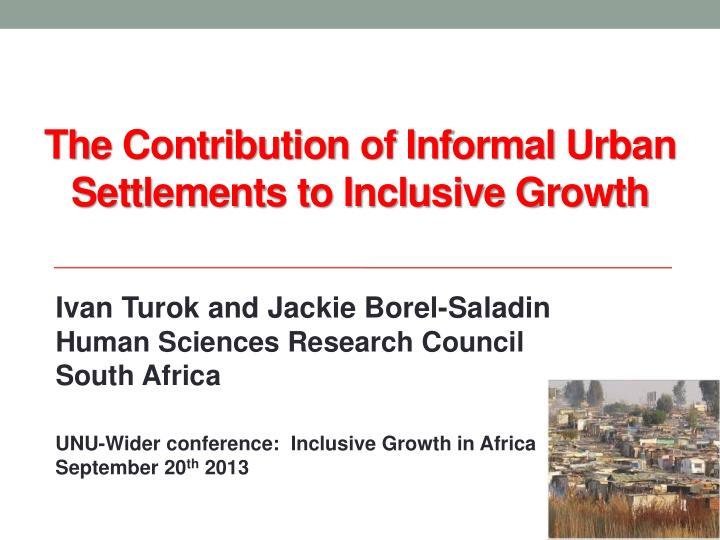



The Contribution of Informal Urban Settlements to Inclusive Growth Ivan Turok and Jackie Borel-Saladin Human Sciences Research Council South Africa UNU-Wider conference: Inclusive Growth in Africa September 20 th 2013
Concepts and definitions Inclusive growth: economic participation distributing the benefits Urbanisation and inclusive growth: agglomeration efficiencies economic dynamism from new entrants access to urban labour and housing markets Government policy: vital for coordination can help or hinder 2
Context: South Africa Distinctive economic and political history Very high unemployment; extreme inequality 62% urbanised. Projected 8m increase by 2030 Rural econ stagnation; modest urban econ growth Cautious economic policies + redistributive welfare Government ambivalent about rural-urban migration And about informal settlements: illegal invasions, criminality, unsightly, unproductive, hazardous locations, new housing solution elsewhere, discontent, opposition Investment restricted to basic emergency services 3
4 Trends in employment 150 140 Total Metros 130 Percentage Total 120 Secondary Cities 110 Rest of South Africa 100 90 1996 1997 1998 1999 2000 2001 2002 2003 2004 2005 2006 2007 2008 2009 2010 2011 2012 Year Source: IHS Global Insight
Context: South Africa Popular response is migration towards urban jobs Swelling informal settlements People sacrifice quality of life for job access Better jobs-population alignment emerging But squalid living conditions 5
Research questions 1. Difference in economic participation between formal and informal urban areas • employment rate? 2. ‘Quality’ of employment – inferior jobs? • incomes • occupations • security 6
Evidence: employment rate 55 50 Urban 45 formal 40 Employment rate (%) 35 Urban informal 30 25 20 Rural 15 10 7 Year and quarter
Despite poorer education 8
Status of non-employed: Nb motivation 9
But poorer quality jobs: Monthly incomes 10
Occupational profile 11
Precarious jobs 12
Employment status 13
14 Conclusions Conceptual : Economic density and access for new entrants – workers, consumers, entrepreneurs Empirical : Entry point/foothold in the urban labour market, but limited Policy : More pro-active, investment in land and basic public services, facilitate formal housing market with multi-storey flats
15 Thank you!
Distorted urban form
RDP housing on the periphery: poverty traps?
Total urban and rural population
Concentrated economic activity
Location is highly contested
Recommend
More recommend